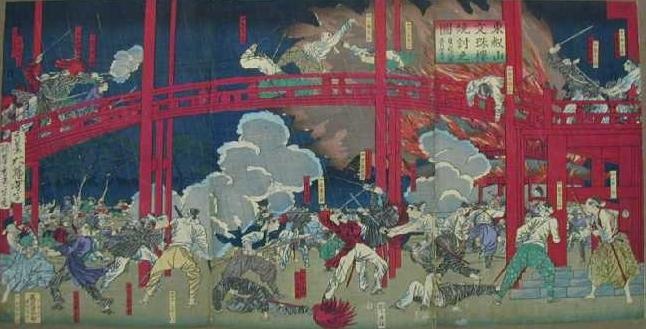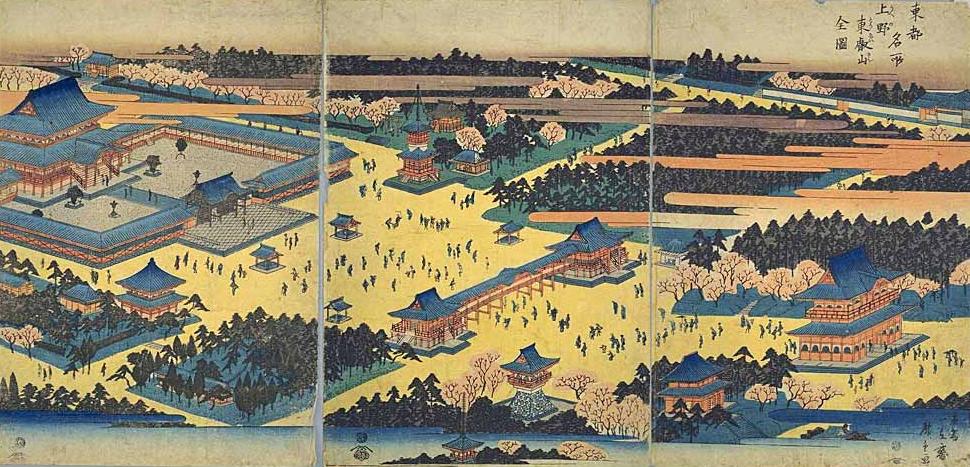
|
|
Copped and cropped from Tokyo Metropolitan Library
|
Toeizan Monjuro Yakiuchi
Keio Boshin 5-15
Monjuro Burning
Keio-4-5-15 [1868-7-19]
Triptych by Yoshitoshi
(assisted by Toshimitsu)
The full title of this triptych, designed by Yoshitoshi with the assistance of Toshimitsu, one of his students, is Toeizan Monjuro Yakiuchi no Zu / Keio Boshin Gogatsu Jugonichi or "Image of Burning of Monju Towers at Toeizan / 15th Day of 5th Month of Boshin [4th] year of Keio]". The date on the solar calendar was 4 July 1868.
The Monju towers were part of the sprawling Toeizan Kan'eiji complex in the Ueno Hills. Kan'eiji, a Tendaishu temple, was built in 1625, after the monk Tenkai (1536-1643) urged the 3rd shogun Tokugawa Iemitsu (1604-1651) to build a government temple to protect the "kimon" (‹S–å) of Edo castle. The "demon gate" is the northeast quarter of a building, complex, or town, an unlucky direction requiring special measures against evil spirits. By the time of the 5th shogun Tokugawa Tsunayoshi (1646-1709), the complex had expanded to 360,000 tsubo -- roughly 1.2 million square meters or 1.1 square kilometers.

|
|
Copped and cropped from www.hiroshige.org.uk
|
Some idea of the layout and spread of Toeizan Kan'eiji can be seen in this triptyph by Ando Hiroshige (1779-1858), called Toto meisho / Ueno Toeizan zenzu or "Famous Places in the Eastern Capital / Entire Image of Toeizan at Ueno". The Monju towers, are the structures in the middle.
In the second month of the year, about 2000 Shogitai members assembled in the complex. When it appeared that they intended to remain there, and possibly attract more support, some 20,000 government troops positioned themselves around the grounds and, on the morning of the 15th of the 5th month, which would have a full moon or there abouts, they attacked the Shogitai holdouts. The Monju towers and many other temple edifices were hit by cannon burned to the ground. The cannon could be heard all over the city.
The triptych by Yoshitoshi and Toshimitsu was designed and published in 1874, half a year after the observance of the 7th-year memorial of those who fell in the 1868 battle. It depicts fighting with swords and shorter lances in the rain and flames that engulfed the Shogitai.
Yoshitoshi did a number civil war triptychs with Toshimitsu's acknowledged help. Toshimitsu did some war prints himself, one in 1871 on the Shinsengumi leader Kondo Isamu (Konishi 1977.4:30). Yoshitoshi did a triptych on Kondo in December 1874 (Konishi 1977.4:30-31). December and December of 1874 were busy months, as many drawers and publishers cranked out all manner of prints to help the public scratch what was apparently a very powerful 7-year itch for Boshin war memorabilia.
What happened then was no different than what happens today in anniversary years of major events, particulars wars and other devastating incidents. In Japan today, there is still some tendency to give space and time in the media to 1st, 3rd, 7th, and 13th year memorials of famous people, or particularly horrible earthquakes, plane crashes, or train wrecks.
Shimamura's Shogitai
The Shogitai appear in the foreground or background of many novels. One, a historical mystery by Shimamura Sho, won the 6th Matsumoto Seicho Prize in 1999. It is called Yoshitoshi meifu hoko (Yoshitoshi's wanders in hades), and the Shogitai figure in the opening pages (Shimamura 1999:11-13).
It was bad enough, just to have been provided a weak-headed nighthawk called something like Oyuki by the Retiree of Yushima, and to draw some erotic pictures, but he had left her at the premises after going so far as to help her with her monthly thing. He figured that come morning the Retiree of Yushima would come to the premises to see how things had gone, and because Rokusuke was at the premises to look after things, he had decided to leave Oyuki there and return to his row house in Okecho in Nihonbashi.
It was a night of a leap-fourth month, and though people clamor about such things, it was quiet as though such things were not true. Or rather this might have been a sign that precisely because people clamor about such things, they were holding their breath and carefully watching how things went.
This year, the fourth of Keio, the collision between the shogunate army and the Satsuma-Choshu army began.
This was the so-called battle of Toba-Fushimi in Kyoto. But the shogunate Army led by Tokugawa Yoshinobu, the Shogun, not surprisingly retreated, and Yoshinobu, who had fled back to Edo [by boat], moved to Daijiin [monastery] within Ueno Kan'eiji temple.
While this was going on the [newly formed] government army continued to push east with the object of pursuing and killing Yoshinobu, and eventually arrived within Edo-fu.
The result of this was that, on the 14th of the fourth month, about a month before the leap-fourth month, Yoshinobu surrendered Edo Castle to the Satsuma-Choshu army and departed for Mito [to live in asylum].
With this, the victory of the government army in Edo became clear to the eye, but Yoshinobu had left a single troublesome thing in Edo.
This was a group called Shogitai.
Shogitai came into being as retainers of the Shogun and vassals of the Hitotsubashi branch of the Tokugawa clan were aggregating a group in order to protect Yoshinobu. At first it was an organization with Shibusawa Seiichiro at its head. It had taken up a position in the hills of Ueno, having been assigned the duty of controlling the streets. But "protecting Yoshinobu", which was one of its objectives, became meaningless with Yoshinobu's departure from Edo.
Then a division occurred within Shogitai.
Standing in opposition to the head Shibusawa Seiichiro, who advocated retreating to Nikko and fighting rather than remaining holed up in the hills of Ueno, was the secondary head Amano Hachiro, who held that maintaining the present state to the end was the way to resist the government army.
As a result, Shibusawa and others left Shogitai, and Amano Hachiro became its leader.
Shogitai, which at first had consisted of about one-thousand members, now swelled to nearly three-thousand. The main party had been organized into eighteen companies, and in addition there was a detached mobile company of interested individuals.
For over a month from the surrender of Edo Castle, the confrontation between this Shogitai in Ueno and the government army that had entered Edo castle continued, and this was how things were in the streets of Edo now.
There was nothing the people of Edo could do but carefully watch how things went.
Make a mistake, and it was not impossible that the streets of Edo would become embroiled in war. But, as for the sentiments of the people, it was certain their sympathies toward the Shogitai were strong. Anger over how the government army, a group of country samurai, had been trampling on the town of Edo, was exceptionally strong.
Even for Yoshitoshi, who did not show a lot of interest in politics, if anything his feelings stood on the side of the shogunate army more than the government army.
It wasn't that he was particularly sympathetic toward the shogunate army.
But, it was a matter of there being a vague anxiety, in the reality where things that made no sense were continuing to press from beyond the seas and completely change the world.
The above excerpt comes from the draft of a translation in progress of the entire novel.
|

